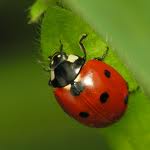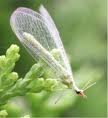 Loading... Please wait...
Loading... Please wait...-
CALL US AT 632-8140854 or 0917-6731947
- My Account
- Items / $0.00
All prices are in All prices are in EUR
Categories
Blog - Permaculture
Integrated Pest Management
Posted by Paula Aberasturi on 5th Feb 2014
Our farm enjoys an eclectic mix of neighbors. A handful of ladies wearing red with black polka-dots; nosy busybodies buzzing around, burly enough that our farmers would sometimes stay out of our greenhouses for fear of their stings; chirpy visitors, some of them laying pretty blue eggs in our leaves-turned-nest; fairy-like creatures with golden eyes; and teeny-weeny ones, among the smallest in the world. The unique bunch do a lot of work for the farm: they rid us of aphids, mites, caterpillars, white flies and other nasty insects. Some say they are part of the farm’s Integrated Pest Management. Others like to call them Beneficial Insects. We would rather call them our FRIENDLY NEIGHBORS. We highlight three of the most fascinating ones here:
LADYBUGS
Don’t mess with adorable ladies in red and black polka dresses. They are quite fearless. In our farm, they have taken on the heroic task of battling aphid colonies, which feed on our young leaves, new shoots and baby buds. Don’t let their tiny bodies deceive you because lady beetles are ravenous! They eat up to 1000 aphids a day. Even as larvae they can eat 500 aphids! And mind you, they do it by stabbing the nasty aphids with their mandibles and sucking out the juices. It is no wonder why the ladybug in ancient times, symbolized good fortune and a bountiful harvest. One fun trivia about lady beetles: In times of danger, ladybugs are able to roll over and play dead.LACE WINGS
Lacewings, Commander in Chief
Another friendly neighbor is the Lace Wing. In an Insect-Eating Contest, lacewings would be adjudged the champions. In a battle, lacewings would definitely be commander. Lacewings are beautiful creatures with delicate netted wings and golden eyes. They look ethereal and you wonder where they get their voracious appetites. As larvae, they feed on aphids, whitefly, mealy bugs, thrips, spider mites and caterpillars. The lacewings can eat 200 or more pest eggs a week during their 2-3 week growth period! They are also our gutsy crusaders against the whitefly. White flies are small insects that cluster under our leaves and stems, and are especially bad for our roses. Not only these, lacewings feed on other insect pests such as mealy bugs (that cause black sooty mold on our plants), thrips (that make our leaves distorted or spreads diseases) and caterpillars too (otherwise we have chewed leaves.)
Recently moved in are the stingless wasps (Trichogramma). These are tiny insects of about 1 millimeter and they control at least 28 species of insect pests. These wasps are one of the smallest insects on the planet. We released 10,000 wasps and they are now roaming about our farm, parasitizing pest eggs. Our wasps are busy “sowing their seeds” into the harmful eggs of caterpillars and moth (the leafeaters,) among others. When the wasps hatch, the larvae will devour the pest egg contents. During their 9-11 day lives, the wasps will seek out and destroy about 50 pest eggs by laying their eggs into the pest eggs. I know it reads like a horror movie but these are naturally occurring in nature. A trivia about wasps: The adult females use their antennae to measure the size of the host egg in order to determine how many eggs to lay in it.
These are just some of the biological controls we use in the farm, as part of Integrated Pest Management. Biological controls eliminate the overuse of chemicals, increasing biodiversity. Our farm is blessed with ladybugs, lacewings, and most recently, are now the happy hosts of stingless wasps. Our friendly neighbors are beneficial insects who pay their rent by ridding our farms with pests while compensated with an abundance of good pests to eat.
Sunflowers as Fertilizer and Pesticide
Sunflowers: Friend or Foe?Sure, wild sunflowers are pretty to look at, but these pretty yellows that look up to the sun are often regarded as weeds or as a menace. They grow everywhere, in hedges, at your backyard, along roadsides. Some farmers slash and burn them! Well, at least some farmers. But let [...]
Green Manuring: Using Legumes for Plant Beds
We use green manuring to help with our composting. Green manures allow us to fertilize and add more organic matter to our soil. Green manuring is a method of putting back into the soil living plants at the peak of their growth. We do this by using leguminous plants (like mung bean, [...]
Truly Greenhouses
We have taken a step farther and have consciously built our greenhouses to be as green as they could be. All our greenhouses are constructed in bamboo. Yes, bamboo! Not those tall, rigid, imposing steel structures, not even concrete, not even hard wood. We do not cut trees! WHY BAMBOO?Prevents global warming: Our greenhouses made entirely [...]








